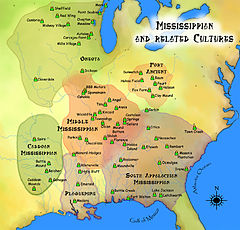- Nechaui
-
The Nechaui were a Native American tribe from eastern Texas.[1] Their name is thought to be derived from Nachawi, the Caddo language word for Osage orange.[2]
Contents
History
The Nechaui were part of the Hasinai branch of the Caddo Confederacy. During the late 17th and early 18th centuries, their principal village was located on the Neches River, in present day Cherokee County, Texas.[2]
In the late 17th century, Spanish explorer, Francisco Casañas de Jesús María encountered the tribe and wrote, "Toward the north, where the above-mentioned Necha tribe ends, is that called the Nacachau."[3] The Nechaui settled near the Nacono and Neche tribes.[4] In 1716, another Spanish explorer, Domingo Ramón wrote that Franciscan monks established a mission to convert the Nechaui and neighboring Hasinai tribes.[3]
Ultimately, they assimiliated into other Hasinai tribes in the 18th century,[2] and are enrolled in the Caddo Nation of Oklahoma today.
Synonymy
The tribe is also known as the Nechavi.[5]
Notes
- ^ Sturtevant, 617
- ^ a b c Nechaui Indians. Handbook of Texas Online. (retrieved 9 Sept 2009)
- ^ a b The Nacachau, Nechaui and Nacono Tribes. Access Genealogy. (retrieved 9 Sept 2009)
- ^ Bolton, 34
- ^ Sturtevant, 629
References
- Bolton, Herbet E. The Hasinais: Southern Caddoans As Seen by the Earliest Europeans. Norman: University of Oklahoma Press, 2002. ISBN 978-0806134413.
- Sturtevant, William C., general editor and Raymond D. Fogelson, volume editor. Handbook of North American Indians: Southeast. Volume 14. Washington DC: Smithsonian Institution, 2004. ISBN 0-16-072300-0.
External links
- Nechaui Indians, from Handbook of Texas Online
Caddo Confederacy Hasinai Kadohadacho Natchitoches Other groups  Pre-Columbian North America
Pre-Columbian North AmericaArchaeological cultures North American pre-Columbian chronology – Adena – Alachua – Ancient Pueblo (Anasazi) – Baytown – Belle Glade – Buttermilk Creek Complex – Caborn-Welborn – Calf Creek – Caloosahatchee – Clovis – Coles Creek – Deptford – Folsom – Fort Ancient – Fort Walton – Fremont – Glades – Glacial Kame – Hopewell (List of Hopewell sites) – Hohokam – Leon-Jefferson – Mississippian (List of Mississippian sites) – Mogollon – Monongahela – Old Cordilleran – Oneota – Paleo-Arctic – Paleo-Indians – Patayan – Plano – Plaquemine – Poverty Point – Prehistoric Southwest – Red Ocher – Santa Rosa-Swift Creek – St. Johns – Steed-Kisker – Tchefuncte – Tocobaga – Troyville
Archaeological sites Angel Mounds – Bandelier National Monument – The Bluff Point Stoneworks – Cahokia – Chaco Canyon – Casa Grande – Coso Rock Art District – Eaker – Effigy Mounds National Monument – Etowah Indian Mounds – Eva – Folsom Site – Fort Ancient – Fort Center – Gila Cliff Dwellings National Monument – Holly Bluff Site – Hopewell Culture National Historical Park – Kincaid Mounds – Kolomoki – Manitou Cliff Dwellings – Marksville – Meadowcroft Rockshelter – Mesa Verde – Moorehead Circle – Moundville – Mummy Cave – Nodena Site – Ocmulgee National Monument – Old Stone Fort – Parkin Park – Pinson Mounds – Portsmouth Earthworks – Poverty Point – Pueblo Bonito – Rock Eagle – Rock Hawk – Salmon Ruins – Serpent Mound – Spiro Mounds – SunWatch – Taos Pueblo – Toltec Mounds – Town Creek Indian Mound – WintervilleMiscellaneous Ballgame – Black drink – Buhl woman – Calumet – Chunkey – Clovis point – Container Revolution – Eastern Agricultural Complex – Eden point – Effigy mound – Falcon dancer – Folsom point – Green Corn Ceremony – Horned Serpent – Kennewick man – Kiva – Metallurgy – Mi'kmaq hieroglyphic writing – Medicine wheel – Mound builders – N.A.G.P.R.A. – Norse colonization of the Americas – Piasa – Pueblo dwellings – Southeastern Ceremonial Complex – Three Sisters agriculture – Thunderbird – Underwater panther
Categories:- Caddoan peoples
- Native American history of Texas
- Native American tribes in Texas
Wikimedia Foundation. 2010.


